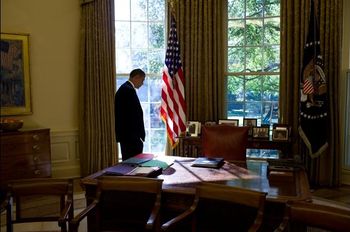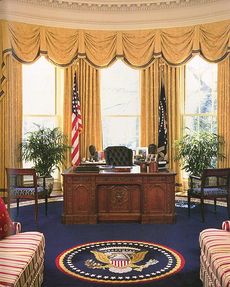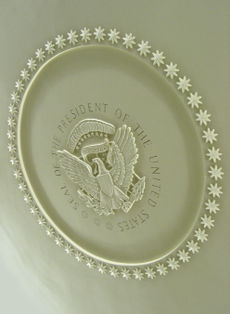Oval Office

The Oval Office in 2009, with President Barack Obama looking out of the Oval Office bay window across the South Lawn.
|

President Barack Obama confers with Secretary of State Hillary Rodham Clinton in the Oval Office, January 27, 2009.
|

The Oval Office in 1999, during the administration of Bill Clinton. President Clinton's office was designed by Arkansan Kaki Hockersmith, who used a vibrant color palette of cream, gold, crimson and sapphire blue.
|

The Oval Office in 1988, during the administration of Ronald Reagan. The drapery originated in the administration of Gerald Ford. President Reagan continued to use the Resolute desk that President Jimmy Carter had returned to the office in his administration. First Lady Nancy Reagan contributed to the design of President Reagan's Oval Office rug and the placement of furniture.
|

The first Oval Office, designed by Nathan C. Wyeth for President William Howard Taft in 1909, was nearly identical in proportion to the current office. It was destroyed by fire in 1929.
|

Exterior of the Oval Office as viewed from the South Lawn
|

An early color photograph of the Oval Office during the administration of Franklin D. Roosevelt.
|

Oval Office floor, replaced during the administration of George W. Bush. Based on a 1933 design by Eric Gugler, the 2005 installation is arranged in a contrasting cross pattern of quarter sawn oak and walnut. Most of the floor is usually covered with an oval rug.
|

Plaster ceiling medallion installed in 1934 includes elements of the Seal of the President of the United States.
|
The Oval Office is the official office of the President of the United States. Created in 1909 as part of an overall expansion of the West Wing of the White House during the administration of William Howard Taft, the office was inspired by the elliptical Blue Room. The room features three large south-facing windows behind the president's desk and a fireplace at the north end of the room.
Presidents generally change the office to suit their personal taste, choosing new furniture, new drapery, and designing their own oval-shaped carpet to take up most of the floor. Paintings are selected from the White House’s own collection, or borrowed from other museums for the President’s term in office.
The Oval Office has four doors: the east door opens to the Rose Garden; the west door leads to a private smaller study and dining room; the northwest door opens onto the main corridor of the West Wing; and the northeast door opens to the office of the president's secretary.
Contents |
Architecture and furnishings
Though architect James Hoban's original design for the White House included oval rooms, the idea of an oval office did not come about until planning for the West Wing expansion in 1909. It was the conception of Theodore Roosevelt, brought out by his wife's idea that the shared space between bedrooms and offices of the White House should be separate. Further, Roosevelt chose the site at least for reasons to demolish a set of greenhouses that were constructed by President Buchanan.[1] An oval interior space is a Baroque concept that was adapted by Neoclassicism. Oval rooms became popular in eighteenth century neoclassical architecture, and it is considered likely that Hoban was influenced by the elliptical chamber at Castle Coole in County Fermanagh, Northern Ireland. That room has identical dimensions, and includes the two recessed niches found in Hoban's original design for the Blue Room. The "elliptic salon"—in the form of the Blue Room and Yellow Oval Room—was the outstanding feature of James Hoban's original plan of the White House. At the temporary "President's House" in Philadelphia, George Washington had two rooms each modified with an apsidal bowed end, which were used for hosting the formal receptions called levees. As his guests formed a circle around him, Washington could stand in the center with everyone an equal distance from the president. The apsidal end of a room was a traditional site of honor, for a host, a potentate, or the magistrate in a basilica.
The president's working office moved from the main residence to the newly constructed West Wing in 1902. At first the president had a rectangular office in the West Wing located just west of the present Cabinet Room. The first Oval Office in the West Wing was designed by Nathan C. Wyeth and constructed in 1909, during the administration of Taft. That office was centered east to west on the south side of the West Wing, much as the oval rooms in the White House residence are. President Taft intended the Oval Office to be the center of his administration. By locating it in the center of the West Wing, he could be more involved with the day-to-day operation of his presidency. The Taft Oval Office had simple Georgian Revival trim, and was likely the most colorful in history; the walls were covered in a vibrant green seagrass. A post card from late in 1909 shown on the right shows Taft's Oval Office.
On December 24, 1929, during the Herbert Hoover administration, a fire damaged the West Wing, requiring substantial rebuilding. President Hoover rebuilt the Oval Office in the same location, upgrading the quality of trim and having the first air conditioning installed. Dissatisfied with the size and layout of the West Wing, President Franklin D. Roosevelt engaged a staff architect, Eric Gugler, to redesign the West Wing with the Oval Office placed in the southeast corner, offering more privacy and easier access to the residence. President Roosevelt worked closely with Eric Gugler and devised a room architecturally grander than the previous two rooms, with more robust Georgian details: doors topped with substantial pediment hoods, bookcases set into niches, a deep bracketed crown molding, and a ceiling medallion of the presidential seal. In small ways hints of Art Moderne can be seen, especially in the representation of the eagle in the ceiling medallion. Roosevelt and Gugler worked closely together, often over breakfast, with Gugler sketching the president's ideas. One notion resulting from these sketches that has become fixed in the layout of the room's furniture, is that of two high back chairs in front of the fireplace. The public sees this most often with the president seated on the left, and a visiting head of state on the right. This allowed President Roosevelt to be seated, with his guests at the same level, deemphasizing his inability to stand on his own accord.
The desk used by many presidents in the Oval Office is a large partners' desk called the Resolute desk, so named because it was built from the timbers of the British frigate HMS Resolute. The desk was a gift of Queen Victoria of the United Kingdom to President Rutherford B. Hayes in 1880. Most recent presidents have hung a portrait of George Washington over the mantel on the north end of the room. A tradition of displaying potted Swedish ivy (Plectranthus verticillatus) atop the mantel goes back to the Kennedy administration, and the current plants were rooted from the original plant. A series of bronze sculptures of horses and Western themes by Frederic Remington are often displayed in the room. A large case clock, commonly called a grandfather clock, built in Boston by John and Thomas Seymour, c. 1795-1805, stands in the northeast portion of the room.
A tradition evolved in the latter part of the twentieth century of each new administration redecorating the office to the President's liking. A new administration usually selects an oval carpet, new drapery, the paintings on the walls, and some furniture. Most incoming presidents continue using the rug of their predecessor until their new one is installed. The retired carpet very often is then moved to the presidential library of the president for whom it was made. The redecoration of the Oval Office is usually coordinated by the First Lady's office in the East Wing, working with an interior designer and the White House Curator. Art may be selected from the White House collection, or may be borrowed for the length of an administration. President Clinton borrowed a bronze sculpture of The Thinker by Auguste Rodin from a museum. President George W. Bush borrowed two oil paintings, A Charge to Keep by W.H.D. Koerner (owned by Bush), and Rio Grande by Tom Lea (on loan from the El Paso Museum of Art).[2]
When President Barack Obama initially took office in 2009, no major redecorations took place of the Oval Office, aside from the removal of the Bush era paintings which were removed and replaced by the American impressionist Childe Hassam's painting The Avenue in the Rain and Norman Rockwell's Statue of Liberty. In August 2010, 20 months after taking over the Presidency, a new look for the Oval Office was unveiled. The centerpiece of the redecoration is a new rug, which is yellow, cream and blue and has five inscriptions woven into it, four quoting Obama predecessors and a fifth from civil rights champion Martin Luther King, Jr. Obama chose a line from Franklin Roosevelt, who held the office during the Great Depression and World War II -- "The Only Thing We Have to Fear is Fear Itself". He also chose King's "The Arc of the Moral Universe is Long, But it Bends Towards Justice.", a line also used in his 2008 victory speech in Grant Park. Other subtle changes are the addition of a hand-carved wooden sculpture obtained by him on a 2006 trip to his ancestral home of Kenya. The figurine shows an egg placed gently into a human hand, symbolizing the fragility of power [1]. He has also replaced the Laura Bush-inspired floral decorations with a bowl of apples and has replaced the decorative plates on the oval office bookshelves with books. New red striped wallpaper, cream brown sofas and a modern designed coffee table have also been installed in the Obama Oval Office.
History
The Oval Office has become associated in Americans' minds with the presidency itself through memorable images, such as a young John F. Kennedy, Jr. peering through the front panel of his father's desk, Richard Nixon speaking by telephone with the Apollo 11 astronauts after their successful voyage, and Amy Carter bringing her Siamese cat Misty Malarky Ying Yang to brighten President Jimmy Carter's day.
Addresses
Uses of the Oval Office for television Oval Office Address broadcasts are rare and reserved for occasions with a sense of gravity, as when a young President Kennedy presented news of the Cuban missile crisis, or President Ronald Reagan addressed the nation following the Space Shuttle Challenger disaster or President George W. Bush addressing the nation the evening of September 11, 2001.
Oval Office carpet
The carpet of the oval office bears the Seal of the President. President Truman's oval carpet was the first to incorporate the presidential seal. In Truman's carpet the seal was represented monochromatically through varying depths of the cut pile. His carpet was used in the Eisenhower and Kennedy administrations. In recent years most administrations have created their own rug working with an interior designer and the Curator of the White House.
Design and materials
Since the present Oval Office's construction in 1934 during the administration of Franklin Delano Roosevelt the room has remained mostly unchanged architecturally. More than any president, FDR left an impression on the room and its use. Doors and window frames have been modified slightly. A screen door on the east wall was removed after the installation of air conditioning. During the Cold War, window panes were outfitted with small vibrators when it was learned that the Soviets had developed a means of reading the effect of voice sound waves on glass panes. President Lyndon B. Johnson's row of wire service teletype machines on the southeast wall required cutting plaster and flooring to accommodate wiring. The Georgian style plaster ornament has been cleaned to remove accumulated paint, and a series of electrified wall sconces have come and gone.
Though some presidents have chosen to do day-to-day work in a smaller study just west of the Oval Office, most use the actual Oval Office for work and meetings. Traffic from the large numbers of staff, visitors, and pets over time takes its toll. There have been four sets of flooring in the Oval Office. The original floor was made of cork installed over soft wood; however, President Dwight D. Eisenhower was an avid golfer and damaged the floor with his golf spikes. President Johnson had the floor replaced in the mid-1960s with wood-grain linoleum. In 1982, President Ronald Reagan had the floor replaced with white pine and oak in a cross parquet pattern similar in design to Eric Gugler's 1933 sketch, which had never been installed. In August 2005, the floor was replaced again under President George W. Bush, in nearly the same pattern as the Reagan floor, but replacing the soft white pine with walnut.
In the late 1980s a comprehensive assessment of the entire house, including the Oval Office, was made as part of the National Park Service's Historic American Building Survey (HABS). Detailed photographs and measured drawings were made documenting the interior and exterior and showing even slight imperfections. A checklist of materials and methods was generated for future conservation and restoration.
Dimensions
| Dimension | US | SI |
|---|---|---|
| Major axis (north-south) | 35' 10" | 10.9 m |
| Minor axis (east-west) | 29' | 8.8 m |
| Height | 18' 6" | 5.6 m |
| Line of rise (the point at which the ceiling starts to arch) | 16' 7" | 5.0 m |
| Approximate Oval Circumference | 102' 5" | 31.2 m |
| Approximate Area | 816.2 sq ft | 75.8 sq m |
The ratio of the major axis to the minor axis is 10.9/8.8 (i.e. about 1.24).
See also
- 10 Downing Street - Official Residence and Office of the Prime Minister of the United Kingdom.
- Langevin Block - Canadian Prime Minister's Office and Privy Council
- Perdana Putra - Malaysian Prime Minister's Complex Office
Gallery
 President Barack Obama plays Golf in the Oval Office with US Senators and Congressmen, harking back to the tenure of Lyndon Baines Johnson |
 The Oval Office from above in 2001, during the administration of George W. Bush. President Bush chose a more somber color palette than his predecessor, using shades of taupe, celadon and navy. The president and Mrs. Bush worked with interior decorator Ken Blasingame on the design of the office. |
 One of many hand-shake photos in front of the fireplace. The President sitting to the viewer's right, the guest to the left. One of the rare images where there is fire in the fireplace (March 2003, the guest is Paul Kagame.) |
References
- ↑ "The White House: Inside America's Most Famous Home" - CSPAN Documentary
- ↑ "Mrs. Bush's Remarks for 100th Anniversary of the West Wing Symposium". - White House Historical Association. - November 13, 2002. - | Light from the Sky: A Tom Lea Retrospective, 1907–2001. - Mid-America Arts Alliance. - (Adobe Acrobat *.PDF document). - Retrieved: 2008-07-05
Further reading
- Portions of this article are based on public domain text from the White House.
- The White House: An Historic Guide. White House Historical Association and the National Geographic Society: 2001. ISBN 0-912308-79-6.
- Abbott James A., and Elaine M. Rice. Designing Camelot: The Kennedy White House Restoration. Van Nostrand Reinhold: 1998. ISBN 0-442-02532-7.
- Clinton, Hillary Rodham. An Invitation to the White House: At Home with History. Simon & Schuster: 2000. ISBN 0-684-85799-5.
- Monkman, Betty C. The White House: The Historic Furnishing & First Families. Abbeville Press: 2000. ISBN 0-7892-0624-2.
- Ryan, William and Desmond Guinness. The White House: An Architectural History. McGraw Hill Book Company: 1980. ISBN 0-07-054352-6.
- Seale, William. The President's House. White House Historical Association and the National Geographic Society: 1986. ISBN 0-912308-28-1.
- Seale, William, The White House: The History of an American Idea. White House Historical Association: 1992, 2001. ISBN 0-912308-85-0.
- West, J.B. with Mary Lynn Kotz. Upstairs at the White House: My Life with the First Ladies. Coward, McCann & Geoghegan: 1973. SBN 698-10546-X.
External links
- Oval Office historical photo essay
- Pictures of the Oval Office during different presidencies (1909-2005)
- Washington Post: "Inside the Real West Wing"
- Oval Office and Presidential desks
- White House Museum online tour: the Oval Office, with history and images from each administration
- The Oval Office on Whitehouse.gov
- Google Sketchup 3D Model
- 2010 Oval Office Makeover
|
||||||||||||||||||||||||||||||||||||||||

